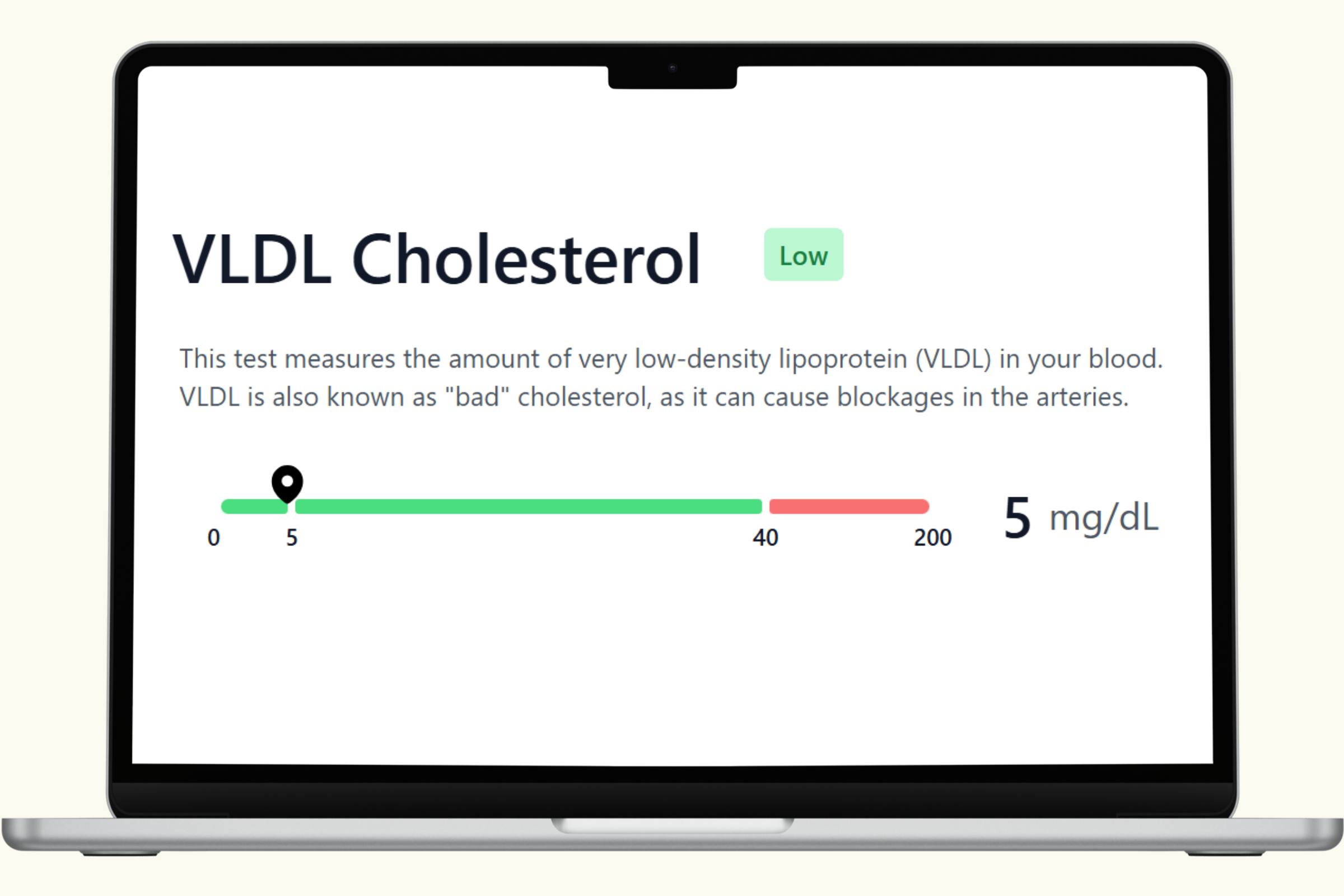VLDL Cholesterol Blood Test
The VLDL (Very Low-Density Lipoprotein) Cholesterol Test estimates the amount of VLDL in your bloodstream, providing an important measure of cardiovascular health. VLDL is a type of lipoprotein that primarily carries triglycerides, a form of fat, through your blood. While your body needs some triglycerides for energy, high levels of VLDL contribute to plaque buildup in your arteries, a process known as atherosclerosis. This buildup increases the risk of heart disease, stroke, and other cardiovascular problems.
As part of the PlexusDx Diabetes & Heart Health Blood Test, the VLDL cholesterol measurement helps you understand your lipid balance in greater detail. With an easy at-home dried blood spot (DBS) collection on an ADX card, you can get accurate results without a lab visit.
What the VLDL Cholesterol Test Measures
Unlike LDL (“bad” cholesterol) and HDL (“good” cholesterol), VLDL is not typically measured directly. Instead, it is estimated based on triglyceride levels, since VLDL particles are rich in triglycerides. The calculation is often performed as:
VLDL (mg/dL) ≈ Triglycerides ÷ 5 (when triglycerides are below 400 mg/dL)
By looking at VLDL levels, you gain insight into how much triglyceride-rich cholesterol is circulating in your body and contributing to potential plaque buildup in arteries.
Why VLDL Matters
VLDL plays a key role in transporting triglycerides, but too much of it in the blood can be harmful. Excess VLDL cholesterol is strongly associated with:
- Atherosclerosis: Plaque buildup in arteries that narrows blood flow.
- Heart disease: Increased risk of coronary artery disease and heart attack.
- Stroke: Higher chance of blood clots and blocked vessels in the brain.
- Metabolic syndrome: VLDL is often elevated in insulin resistance, obesity, and type 2 diabetes.
Because VLDL is closely linked to triglyceride levels, it often rises with poor diet, lack of exercise, excess weight, or certain medical conditions. Monitoring this marker provides a more complete view of your cardiovascular risk.
Reference and Functional Ranges
While labs may vary slightly in their ranges, the following are commonly used cutoffs for VLDL cholesterol:
- Optimal: 5 – 30 mg/dL
- Borderline High: 30 – 40 mg/dL
- High: Above 40 mg/dL
In functional medicine, the goal is often to keep VLDL below 20 mg/dL to reduce long-term cardiovascular risk.
How the Test is Collected
The PlexusDx Diabetes & Heart Health Blood Test uses an at-home dried blood spot (DBS) collection method with an ADX card. A simple finger prick provides a few drops of blood, which are applied to the card and mailed to the lab. This method is:
- Quick and convenient
- Less invasive than venous blood draws
- Clinically validated for accuracy
- Ideal for ongoing monitoring of cardiovascular health
Factors That Influence VLDL Levels
Several lifestyle and medical factors can impact your VLDL cholesterol:
- Diet: High intake of refined carbs, sugars, alcohol, and saturated fats raises triglycerides and VLDL.
- Exercise: Regular physical activity lowers triglycerides and reduces VLDL.
- Weight: Excess body fat, especially around the abdomen, often elevates VLDL.
- Alcohol: Drinking too much can raise triglycerides and VLDL levels significantly.
- Medical conditions: Type 2 diabetes, insulin resistance, hypothyroidism, and kidney disease can all increase VLDL.
- Genetics: Familial lipid disorders may predispose some individuals to high VLDL regardless of lifestyle.
How to Improve VLDL Cholesterol
The good news is that lifestyle and treatment options can significantly lower VLDL and triglycerides:
- Follow a heart-healthy diet: Focus on vegetables, whole grains, lean protein, and healthy fats like omega-3s.
- Cut back on sugars and refined carbs: Reducing added sugar lowers triglycerides and improves lipid balance.
- Exercise regularly: Both aerobic activity and strength training help lower triglycerides.
- Lose weight: Even a 5–10% reduction in body weight can lower VLDL significantly.
- Limit alcohol: Excess alcohol strongly raises triglyceride and VLDL levels.
- Consider medications: If lifestyle is not enough, doctors may prescribe statins, fibrates, or omega-3 supplements to reduce VLDL.
Why Pair VLDL with Other Biomarkers?
VLDL is best interpreted as part of a broader lipid panel, including LDL, HDL, triglycerides, and cholesterol ratios. The PlexusDx Diabetes & Heart Health Blood Test combines these markers with glucose and hemoglobin A1C for a comprehensive view of both metabolic and cardiovascular wellness.
Take Control of Your Heart Health
The VLDL Cholesterol Test provides important insight into triglyceride-rich lipoproteins that drive plaque buildup and cardiovascular risk. By using the PlexusDx at-home collection method, you can easily monitor your cholesterol profile and make informed changes to protect your heart. Whether through diet, lifestyle, or medical care, lowering VLDL levels is one of the most effective ways to reduce your risk of heart disease and stroke.

Share:
Triglycerides Blood Test
Glucose Blood Test